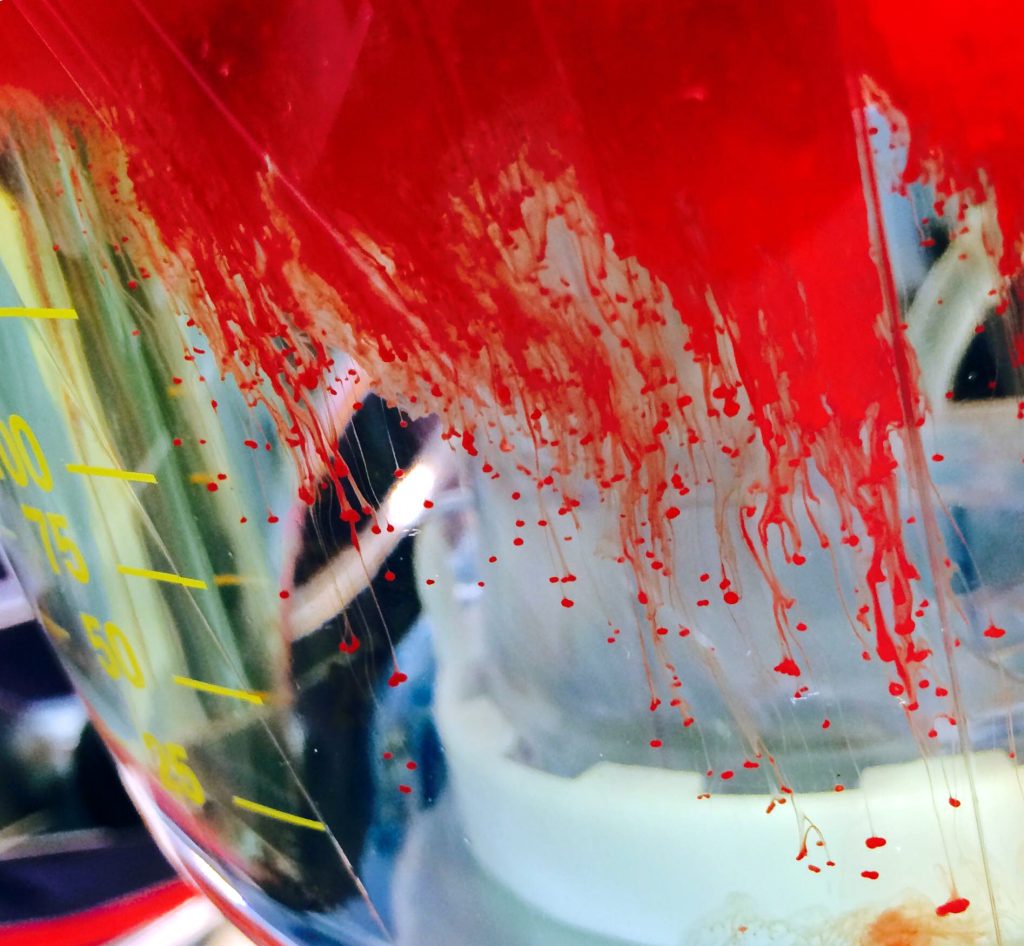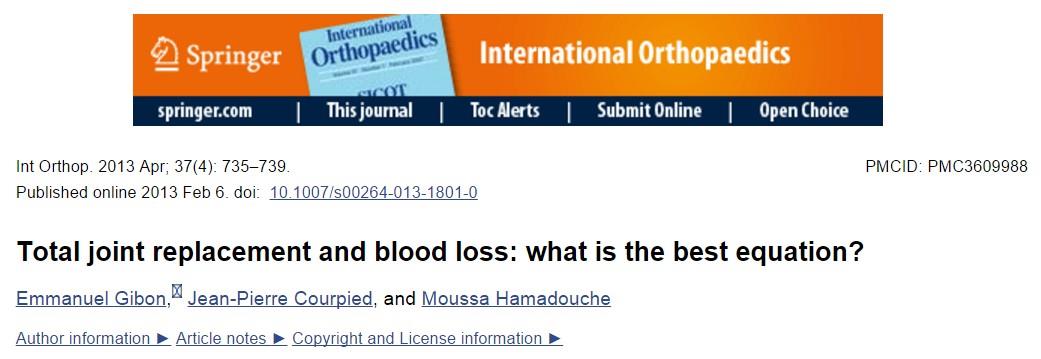How to Calculate EBL with Cell Savers

“It was simple- but in theory is consistent with other ways I have used to extrapolate that mysterious number we always come up with- that is sometime just barely a step away from ‘home cooking’.”
Editor’s Note:
Well, I was @ a new venue, doing a locum’s gig- and ran into an interesting formula/calculation for estimating blood loss based on cell saver volume and the number of bowls returned to the patient. It was simple- but in theory is consistent with other ways I have used to extrapolate that mysterious number we always come up with- that is sometime just barely a step away from “home cooking”.
Oh BTW- A shout out to Chris– who engaged me in a lot of fun and elegant conversations regarding this as well as a myriad of other perfusion topics!
=
The calculation is as follows:
- ((Bowl volume/2) / avg hct expressed as a fraction)) X # of Bowls returned to the Pt.
As a result I looked up a pretty interesting study (see below) comparing many different calculations of the same ilk. See what you think-
And please- if you have your own equation that you use- Plz Share?
Thanks 🙂
Frank
Click image to view source article
–
Methods based on the haematocrit
Mercuriali’s formula [13]
This formula is based on the preoperative haematocrit (Hctpreop) and fifth post-operative day haematocrit (Hctday 5 postop). The haematocrits must be written as decimal fractions. This formula requires the patient’s blood volume (BV) calculated through the Nadler formula [14] (in millilitres of blood) and requires the volume of red blood cells (RBC) transfused as well. Therefore, this estimation using the Mercuriali formula is expressed in millilitres of RBC:
The volume of RBC transfused is based on the number of RBC in one blood unit pack. This number is different from one institution to another.
Bourke’s formula [15]
Bourke and Smith first described the blood loss as the natural logarithm of the ratio of initial to final haematocrit. Thus, to make it easily memorable for use in the operating room, Bourke and Smith rearranged the equation to obtain a “simplified” equation:
rewritten to obtain:
where BV is calculated using Moore’s formula and haematocrits are written as decimal fractions. Hct0 represents the value of the haematocrit in initial conditions and Hctt is the value of the haematocrit at t time. The time when the blood sample must be taken for Hctt is not clear. Hctmean is the average between the initial and final haematocrits. The estimated blood loss using Bourke’s formula is therefore expressed in millilitres of blood.
Ward’s formula [16]
Ward et al. based their formula on works of Furman et al. [17] in paediatric surgery. The aim of the work of Ward et al. was to create a formula which fits a relevant clinical situation: slow blood loss and volume replacement with colloid/crystalloid, therefore maintaining the intravascular volume near normal. Ward et al. tested the following formula in dogs and humans:
where Hctf is the final haematocrit value drawn before transfusion or at the end of the surgery and Hcti is the initial haematocrit before surgery. The estimated blood loss using Ward’s formula is therefore expressed in millilitres of blood.
Gross’ formula [18]
Gross designed a new formula to make the blood loss estimation easier than using the Bourke or Ward formula. Indeed, he found the Ward formula was not easy to use in routine practice due to the natural logarithm function and found the Bourke formula was “cumbersome and difficult to remember”. Therefore, his new formula, derived from the logarithmic equation was:
where EBV is calculating using Moore’s formula; Hct0 is the initial haematocrit before surgery, Hctf is the patient’s minimum allowable haematocrit and HctAV is the average of the initial and minimum haematocrit.
Gross tested his formula in adult patients undergoing major procedures including THA. The estimated blood loss using Gross’ formula is therefore expressed in millilitres of blood.
Brecher’s formula [19]
With the goal of designing a very accurate and reproducible method of blood loss estimation in order to have an estimation which could fit 90 % of patients for a given procedure, Brecher et al. divided the surgical procedure into three phases and the final estimation is the sum of each estimation calculated for each phase. Their work was based on the concept of “acute normovolaemic haemodilution” where the patient’s blood volume is maintained using volume replacement solution until the minimum haematocrit allowable.
Lisander’s formula [20]
Lisander et al. created their formula to test whether or not autotransfusion could decrease allogeneic blood transfusion with a minimum allowable haematocrit of 33 %. The estimated blood loss is expressed in millilitres of RBC, haematocrit values are in percentage and the formula is:
where BV is calculated using Nadler’s formula; Hcti is the preoperative haematocrit, Hcte is the haematocrit at the end of the hospital stay, Vtis the volume of allogeneic RBC transfused and Va is the volume of RBC returned by the autotransfusion device. Volumes are all in millilitres. Lisander et al. tested their model on patients undergoing THA and concluded that autotransfusion has a poor effect towards decreasing the need for allogeneic blood transfusion. The estimated blood loss using Lisander’s formula is expressed in millilitres of RBC.
Method based on the haemoglobin
Meunier’s formula [21]
Meunier et al. tested the haemoglobin (Hb) dilution method with blood donors in order to know whether or not this method is accurate for blood loss estimation:
where BV is calculating using Nadler’s formula; Hbi and Hbe are the Hb concentrations before and on a given day after blood donation, respectively. Meunier et al. compared the estimated blood loss and the donated blood volume from day one to day 14 post-donation. They showed that the minimum Hb concentration was reached on day six and at this time the difference between the two volumes was 30 %. Therefore, they concluded that the haemoglobin dilution method dramatically underestimates the true blood loss. With this method, the estimated blood loss is expressed in millilitres of blood.
Other methods
=
The remaining methods consist in weight swabs, drapes and drainage bottle volumes. Most of the time these methods are used all together. However, some authors [7, 22, 23] used the volume in the drainage bottle as a sole method to estimate blood loss.
Estimated blood volume
Among the formulas, the blood volume is mainly estimated using Nadler’s formula [14], which takes into account the gender, the weight and the size. Therefore, the formula is different for females and males. The formula is:
Discussion
=
The number of Americans older than 65 years will increase by 104 % in 2030 [24]. Given the fact that 60 % of this population will have more than one chronic disease, the question of blood loss in major orthopaedic surgery is critical. Blood loss in TKA and THA usually represents at least 20 % of the blood volume, which is balanced either by colloid/crystalloid or units of blood. However, we have shown that there are many ways to estimate blood loss in orthopaedic surgery, but they all differ with regard to accuracy, precision and ease of use.
Most of the formulas were initially designed to better estimate blood loss during surgery and thereby to decrease blood wastage, which is the reason why studies using these formulas have focused on autologous blood donation. However, with an exponential increase of new surgical techniques, devices and biomaterials in orthopaedic surgery, these formulas came to be used by surgeons in clinical research to compare the blood loss.
The best formula would be close enough to the real blood loss to be accurate and user-friendly for routine use. Thus, formulas containing a logarithmic function seem to be cumbersome for routine use. Bourke et al. rewrote their initial logarithm function into an easier formula; however, due to the lack of accuracy on the timing of the final blood sample, this formula is hard to reproduce.
Gross used the patient’s minimum allowable haematocrit as the final value. Therefore, his formula better fits a use for autologous blood donation calculation rather than a use for prospective or retrospective studies.
Brecher et al. divided the surgical procedure into three phases thereby increasing the number of calculations and the complexity. Moreover, Brecher et al. used an exponential function in their calculation which is hard to use routinely. Although very accurate by taking into account the acute normovolaemic haemodilution in their calculation, the Brecher formula is cumbersome for routine use. Lisander et al. designed a formula to estimate the autologous blood donation in order to keep a minimum allowable haematocrit as low as 33 %. However, 32 % of the patients required an additional allogeneic blood transfusion indicating the lack of accuracy to predict the required volume to transfuse with this formula.
Moreover, in Lisander’s formula, the final Hct is the value at the patient’s discharge, which may be very different from one patient to another. Mercuriali et al. designed a formula based on the haematocrit at post-operative day five plus the volume of RBC transfused. It has the advantage of being very clear in time, well reproducible and user-friendly in routine practice. However, it suggests that there is no blood loss after the fifth post-operative day and that the haematocrit reaches its minimum value at this time. Nevertheless, as the patient’s own erythropoiesis begins by post-operative day six as shown by Meunier et al. [21], Merculiari’s formula is particularly interesting as it avoids this confounding bias.
Meunier et al. tested their formula with a blood donation model of 10 % of the blood volume. They found out that the lowest haemoglobin value was reached at the sixth post-donation day meaning the onset of erythropoiesis. Furthermore, they showed a difference of 30 % between the blood donation volume and the calculated volume using the haemoglobin dilution method. With such an underestimation, this formula is not recommended for acute blood loss estimation. Other methods such as weight swabs, drapes and drainage bottles are not reproducible with the exception of drainage bottle volumes. Such methods are not suitable for preoperative blood loss estimation but could be used for clinical studies albeit not accurately. Lastly, to convert millilitres of RBC to millilitres of blood, the mean Hct must be used. This mean Hct is the average between the preoperative Hct and the final Hct depending on the formula. The key is to use a rule of three. For example, with an estimated blood loss of 700 ml of RBC and a mean Hct of 35 %, the conversion would be: .
Conclusion
=
Many formulas to estimate blood loss in surgery are available. However, these formulas have different features, which can be used either for preoperative blood loss estimation or prospective/retrospective clinical studies. Taken together, Mercuriali’s formula is, in our opinion, the most suitable formula for comparable studies regarding blood loss in surgery. For a more meaningful result, a conversion to millilitres of blood should always be done.
Contributor Information
=
Emmanuel Gibon, Phone: +33-1-58413051, Phone: +33-1-58413122, Email: [email protected].
Jean-Pierre Courpied, Phone: +33-1-58413051, Phone: +33-1-58413122, Email: rf.sirap-poh-pa.hcc@deipruoc.
Moussa Hamadouche, Phone: +33-1-58413051, Phone: +33-1-58413122, Email: [email protected].
References
=

